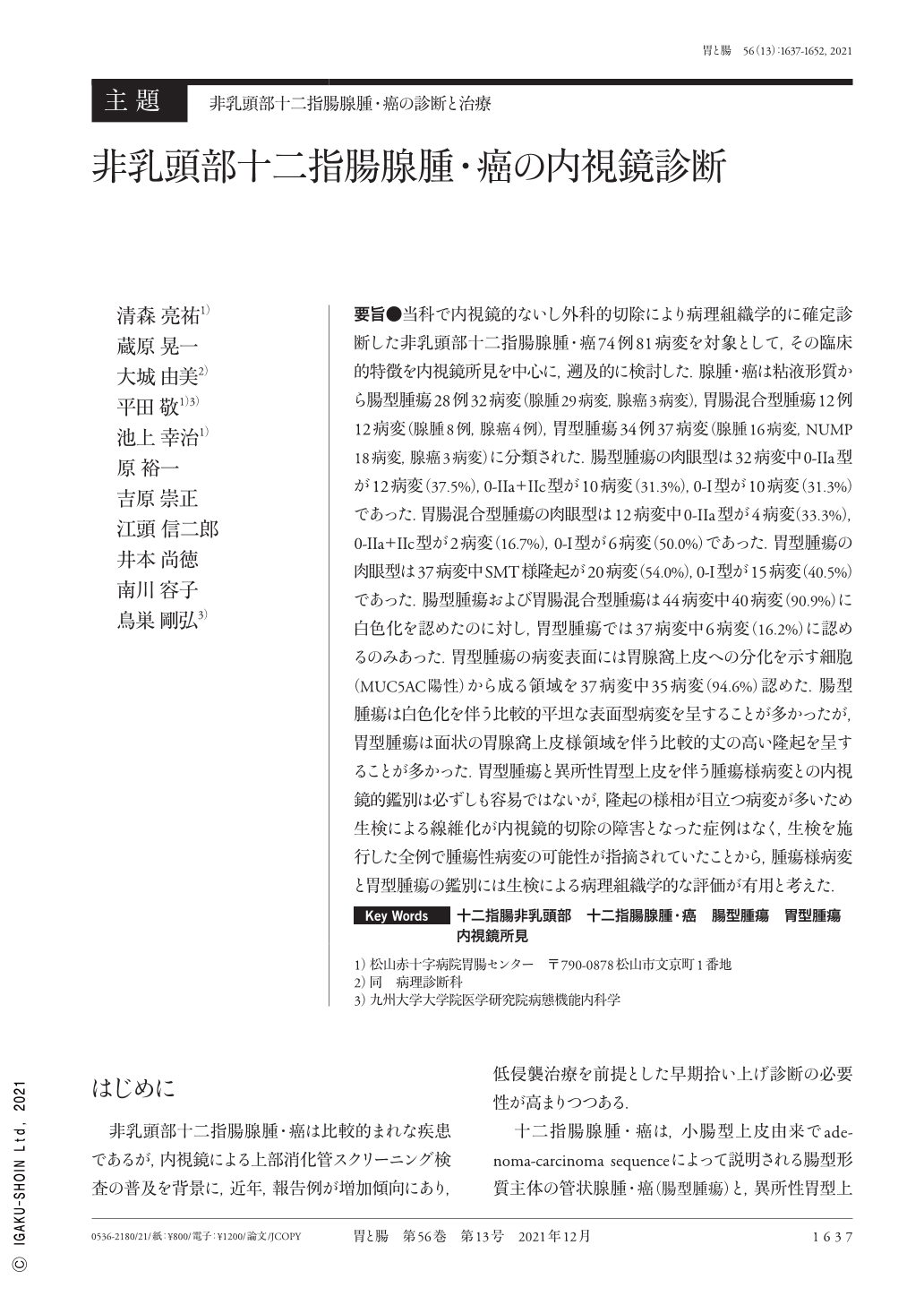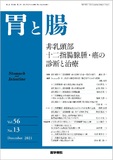Japanese
English
- 有料閲覧
- Abstract 文献概要
- 1ページ目 Look Inside
- 参考文献 Reference
- サイト内被引用 Cited by
要旨●当科で内視鏡的ないし外科的切除により病理組織学的に確定診断した非乳頭部十二指腸腺腫・癌74例81病変を対象として,その臨床的特徴を内視鏡所見を中心に,遡及的に検討した.腺腫・癌は粘液形質から腸型腫瘍28例32病変(腺腫29病変,腺癌3病変),胃腸混合型腫瘍12例12病変(腺腫8例,腺癌4例),胃型腫瘍34例37病変(腺腫16病変,NUMP 18病変,腺癌3病変)に分類された.腸型腫瘍の肉眼型は32病変中0-IIa型が12病変(37.5%),0-IIa+IIc型が10病変(31.3%),0-I型が10病変(31.3%)であった.胃腸混合型腫瘍の肉眼型は12病変中0-IIa型が4病変(33.3%),0-IIa+IIc型が2病変(16.7%),0-I型が6病変(50.0%)であった.胃型腫瘍の肉眼型は37病変中SMT様隆起が20病変(54.0%),0-I型が15病変(40.5%)であった.腸型腫瘍および胃腸混合型腫瘍は44病変中40病変(90.9%)に白色化を認めたのに対し,胃型腫瘍では37病変中6病変(16.2%)に認めるのみあった.胃型腫瘍の病変表面には胃腺窩上皮への分化を示す細胞(MUC5AC陽性)から成る領域を37病変中35病変(94.6%)認めた.腸型腫瘍は白色化を伴う比較的平坦な表面型病変を呈することが多かったが,胃型腫瘍は面状の胃腺窩上皮様領域を伴う比較的丈の高い隆起を呈することが多かった.胃型腫瘍と異所性胃型上皮を伴う腫瘍様病変との内視鏡的鑑別は必ずしも容易ではないが,隆起の様相が目立つ病変が多いため生検による線維化が内視鏡的切除の障害となった症例はなく,生検を施行した全例で腫瘍性病変の可能性が指摘されていたことから,腫瘍様病変と胃型腫瘍の鑑別には生検による病理組織学的な評価が有用と考えた.
Clinical and endoscopic findings of 74 patients with 81 lesions that were definitively diagnosed as non-ampullary duodenal adenoma/adenocarcinoma based on endoscopic or surgical histopathology in our department were retrospectively reviewed. Non-ampullary duodenal adenoma/adenocarcinoma classification by mucin phenotype included 32 intestinal-type tumor lesions of 28 patients(29 adenoma and 3 adenocarcinoma lesions), 12 mixed(intestinal-gastric)-type lesions of 12 patients(8 adenomas, 4 adenocarcinomas), and 37 gastric-type lesions of 34 patients(16 adenoma lesions, 18 neoplasms of uncertain malignant potential, and 3 adenocarcinoma lesions). The 32 intestinal-type tumors were classified macroscopically into 12 0-IIa type lesions(37.5%), 10 0-IIa+IIc type lesions(31.3%), and 10 0-I type lesions(31.3%). The 12 mixed-type tumors were macroscopically classified into 4 0-IIa lesions(33.3%), 2 0-IIa+IIc type lesions(16.7%), and 6 0-I type lesions(50%). The 37 gastric-type tumors were macroscopically classified into 20 submucosal tumor-like elevated lesions(54.0%)and 15 0-I type lesions(40.5%). Further, 40 of the 44 intestinal- and mixed-type tumors(90.9%)were observed to have whitened surface compared with only 6 of the 37 gastric-type lesions(16.2%). On the lesion surface of the gastric-type tumors, areas comprising MUC5AC-positive cells with gastric crypt epithelization were identified in 35 of 37 lesions(94.6%). Intestinal-type tumors were often whitened, relatively flat, surface-type lesions, whereas the gastric-type tumors were frequently observed as crypt epithelium sheet-like areas of relatively highly elevated lesions. It is not always easy to endoscopically differentiate between gastric-type tumors and tumor-like lesions with ectopic gastric-type epithelium. However, there have been no cases in which biopsy-linked fibrosis hampered an endoscopic resection owing to the abundance of lesions with an elevated aspect. The potential presence of tumorous lesions was noted in all patients who underwent biopsy ; thus, histopathological assessment by biopsy was considered effective for differentiating between tumor-like lesions and gastric-type tumors.

Copyright © 2021, Igaku-Shoin Ltd. All rights reserved.


